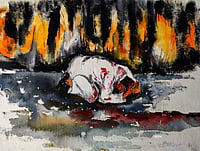A language flourishes when it has a growing number of readers and writers engaging with its literature. The count of people who can read and write in Urdu in its rasmul khat, the Perso-Arabic script called nastaliq (written from right to left), however, has been diminishing constantly. “It’s a serious problem. For that’s how languages die: by losing its script,” says Hindi novelist and former Jamia Millia University professor Abdul Bismillah, who is also well-versed in Urdu. Bismillah is not unduly alarmed by the rapid ‘Hindisation’ of Urdu, which has seen too many Urdu writers raring to get their works published in Devanagari script through Hindi publishers. He is merely expressing a concern shared by many Urdu-wallahs. Writers choosing Hindi publishers fear that with little readership for Urdu books, their efforts to create an identity for themselves through their language and script will be a non-starter, as whatever they write will be lost in a moribund script few can read.
“Urdu is a nation unto itself… Wherever Urdu goes, it clasps people in a bear hug. It becomes a tradition unto itself. For Urdu is, after all, the lingua franca of a culture,” wrote Gulzar in the foreword to The Taste of Words: An Introduction to Urdu Poetry, edited and translated by Raza Mir (Penguin Books, 2014), which brought together a selection of around 150 poems from 50-odd poets—from the canon as well as the contemporary landscape of Urdu poetry. It’s hard not to see Gulzar’s description of Urdu as a language laced with poetic flourishes. While Urdu may continue to charm people everywhere, the fact remains that those who can read it are few and far between.
The issue of the decline of the Urdu language—often linked with political apathy and discrimination—has raged on for several decades. A few months before the 1974 Uttar Pradesh assembly elections, members of the Jan Sangh warned of a “conspiracy” to appease Muslims and targeted the Indira Gandhi government at the Centre for its efforts to make Urdu the second official language. “Urdu, an elegant, supple language shaped by poets and peasants, has slipped into darkness in its Indian homeland. The language, spoken by millions, has fallen victim to controversy because of its political and religious ties to Muslims and Pakistan. To Urdu lovers as well as to the Indian government and Prime Minister Indira Gandhi, the decline of the language is an uneasy and fearful sign of intolerance,” reported Bernard Weinraub in The New York Times on August 5, 1973. Indira Gandhi, who saw the decline of Urdu as “a symptom of apathy, Hindu chauvinism and anti-Muslim feeling,” had formed a committee under I.K. Gujral to promote Urdu, and constantly urged state governments to emphasise the teaching of Urdu.
In New India, things are not easy for Urdu, a symbol of India’s syncretic culture, and the official language of Pakistan. BJP-ruled states are not filling vacancies for Urdu teachers. Urdu-medium schools have been crushed. Urdu is not compulsory at any level, even as Hindi is taught at least till Class X. Even though some of the greatest Urdu writers—from Brij Narayan Chakbast and Tilok Chand Mehroom, to Firaq Gorakhpuri and Krishna Bihari Noor—were from the majority community, Urdu is being seen as the language of the minority. Bismillah terms this ‘linguistic communalism’. Despite all this, some Urdu writers and critics remain hopeful that Urdu will survive against all odds. “Urdu has been maligned repeatedly, especially after Partition. But are not 70 years enough to finish off a language? Yet, Urdu survives. Why? Languages do not obey agendas; they grow, shrink or die only by their inner genius. Urdu’s script, of course, was dealt a blow when it was denied its democratic place in the three-language formula, but its genius has found other avenues to survive,” Urdu’s foremost critic Gopi Chand Narang told this reporter in a 2020 interview.
Some Urdu writers and academicians feel the Devanagari takeover is putting the Urdu script in danger. Jawaid Hassan, assistant professor at Jamia Millia Islamia’s Urdu department, sees the transliteration of Urdu literature in Roman and Devanagari as part of a larger ‘gameplan’ to dilute Urdu’s identity. “The works of all Urdu writers, from Manto and Chughtai to Faiz and Faraz, have been proactively published in Hindi. Tomorrow, when everything will be available in Hindi, we may be told that we don’t need the Urdu script anymore.”
Big Hindi publishing houses like Rajkamal Prakashan, Rajpal and Sons and Vani Prakashan have been publishing Urdu literary works for several years. Rajkamal has published across genres—fiction, poetry and even literary criticism; and periods—Ibne Insha, Mirza Ghalib, Faiz Ahmad Faiz, Parveen Shakir, Intizar Husain, Shamsur Rahman Farooqui, Shamim Hanafi and others. Recently, Vani published a four-volume set of Qurratulain Hyder’s autobiographical novel, Kaare Jahan Daraaz Hai.
After two devastating years of the pandemic, most small-time Urdu publishers have been forced to shut shop and move to some other business, but a few like Arshia Publications (Delhi) continue to soldier on. The brainchild of Izhar Nadeem, Arshia began publishing in earnest in 2009, with an aim to disrupt the way Urdu books were being produced—poor printing and binding, and unattractive covers adorned with phool-patte (flowers and leaves) to cut costs. “It was a different scene. Circumstances were better. Many books were being published in Urdu, but we wanted to break the old format. Our covers are aesthetically designed. We don’t compromise on our production quality. We use cream paper, which is used by big English publishers in India and the West,” says Nadeem, who had to face stiff opposition from competitors for his rebellion against the old way of producing books.

While Arshia is a passion project for Nadeem, his Hindi publishing initiative, Aakhar Prakashan, which he started over five years ago, brings the commerce—books in Devanagari tend to sell more. The ravages of the pandemic and increasing government control have left Arshia reeling. “It’s a struggle for survival. We have got to sustain, and, at the same time, maintain the standard of production.” In one year, Arshia publishes about 50-60 new titles and 15-20 reprints. Some of the titles it has published have been received well, with many going into reprints. They include Rahman Abbas’s Zindeeq, Ghazanfar’s biographical novel Dekh Li Duniya Ham Ne, Syed Mohammad Ashraf’s Aakhiri Swariyan, Yaqoob Yawar’s Dhawaldweep and Khalid Jawed’s Maut Ki Kitaab.
A book going into several reprints, however, may not mean that it’s being read widely. Urdu writers often get published with the financial aid of government institutions like the Urdu Academy and the National Council for Promotion of Urdu Language (NCPUL), or by sharing a part of the costs with their publishers. There are many writers who chose the self-publishing route, too, bearing the entire cost of production. Once a book gets published with aid, the public body sometimes buys back its copies in bulk. Often, writers distribute their books in their circles as hadiya (gift). “If you give away books to your friends and admirers, what’s the guarantee that they are being read? Why do we write? For readers. Unless we can build a readership for Urdu books, things are not going to change,” says Bismillah.
“Urdu literature is being read in Devanagari, but the problem of Urdu language remains; it continues to languish. If it is compared to a tree—instead of watering its roots—we’re merely sprinkling water on its leaves,” says Nadeem. Over the years, Urdu academies have also changed their priorities. Earlier, they focused on getting new writers published, but these days, their resources are being funnelled for seminars and mushairas. In cities like Lucknow, Delhi and Hyderabad, which were once centres of Urdu, little is happening to promote the language. In Hyderabad, for instance, people read the Quran in Telugu. And the headstones at the ITO graveyard in Delhi are all written in Hindi.
Urdu books that see the light of day lack marketing muscle for promotions. If credible publishers like Educational Book House take up self-published works, they are often hesitant to bring these out under their own brand name. In fact, publishers register their companies under multiple names precisely for this purpose. An Urdu writer should ideally get published in Urdu, but very few are lucky enough to do so.
Bismillah finds the process of applying to public bodies for grants tiresome. “Unka tantra alag hai (Their system is different). You are required to submit your manuscript, which a committee has to clear. They will give financial aid to only those books that are not critical of the government,” he says. NCPUL director Aquil Ahmed agrees that only those books that steer clear of controversy make the cut. NCPUL publishes about 40-50 titles across genres every year. Under its grants-in-aid scheme, it buys back books worth Rs 30,000. “There are many writers who get published, but they don’t sell. It’s the publisher’s job to sell, not ours,” he says. NCPUL published RSS Sarsanghchalak Mohan Bhagwat’s Mustaqbil Ka Bharat last year and will bring out Yashasvi Bharat sometime this year. “The Urdu world should know his thoughts,” says Ahmed.
Both Hindi and Urdu writers say there must be an emphasis on teaching the script and moulding young minds towards reading literature. “Instead of fostering love for both, we have created a distance between the two languages. Who will bridge this gap?” asks Bismillah.

























